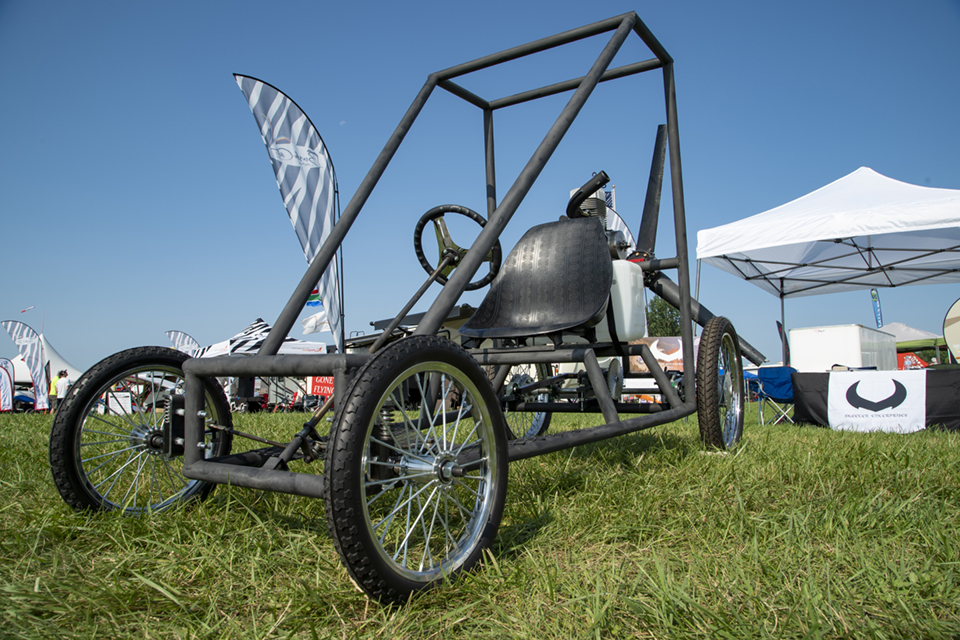From Humble Beginnings
By John W. Conrad
July 26, 2019 - A tribute to EAA founder Paul Poberezny at the museum says, "He came from humble beginnings, yet he created one of the world's largest aviation organizations." Indeed that is the history of aviation, and though we now speak of experimental aircraft as something removed from the mainstream, in our beginnings all aircraft were experimental. On the floor of the EAA Aviation Museum you will see a replica of the first Wright Flyer. It's square, rather crude looking, and of all things features chain-drive propellers. From that square-looking, chain-driven prototype came everything else you will see at EAA AirVenture Oshkosh. Remember that: square-looking, chain-drive.
Near the Wright Flyer you will also see a beautifully restored 1946 Taylor Aerocar. It was an idea, an experiment, a car that could fly or an airplane that could be driven down the road. Any pilot who has ever been struck in traffic has wished she could spread her wings and fly. And many a pilot has been at an airport and wished he could just drive a mile or two down the road. There has always been that desire to blend a flying vehicle with a terrestrial one, and there are a few examples out there. The engineering problem has always been the same. Good cars make lousy airplanes, and vice versa.
The latest attempt to blend flying with driving is the Skeeter Valkyrie, which looks remarkably like the progeny of a midnight dalliance between a sand rail and a powered parachute. It features a 4130 steel cage with a fiberglass seat, four wire wheels on the ground, and a 27-hp Hirth engine in pusher configuration behind the single pilot. But there, under the engine and behind the pilot, is where the magic happens. Rather than driving the propeller directly, or through a gearbox bolted on to the engine, the Valkyrie drives the propeller with a chain from a centrifugal clutch on the engine to the gearbox and propeller drive shaft. That's right, a chain-driven prop just like the first Wright Flyer. When you are through flying, you simply fold the parachute on top of the vehicle, disconnect the chain from the propeller gearbox, and reroute the chain down to the drive shaft for the wheels. And then, presto! What was, minutes before, a flying machine is now an ATV.
The Skeeter Valkyrie presents itself to be the only CFR Part 103 compliant flying ATV. It requires no pilot certificate to fly and is advertised to move 35 mph across the ground and 40 mph through the air.
Six months ago, Sean "Skeeter" Sherman, designer, CEO, and director of marketing and sales of Skeeter Enterprises, was in the U.S. Air Force and working for the Air Force Research Laboratory at Wright-Patterson Air Force Base in Dayton, Ohio. Today he is at the Ultralights area of AirVenture with a prototype, a new idea, a humble beginning if you will, looking to sell his product and develop a market.
To find Skeeter Sherman and his Valkyrie walk south along the flightline, Wittman Road, with the main runway on your left. Put the glitter and glitz of the polished and perfected aircraft in the central display area behind you, and walk past the Vintage area with the Red Barn on your right. Walk past the red Vintage pylon, walk past the blue Ultralights pylon, and then walk some more. As you reach the end of the ultralight display area, look to your right and you will find Skeeter and his Valkyrie — a table, a couple of chairs, a prototype, an idea, and hope — a humble beginning. You might buy one. He is offering a total of 15 percent in discounts. But at the very least, you and your children or grandchildren might return to AirVenture in 20 years and you can tell them that you were there at the start of the Valkyrie. Here is where humble beginnings lead to greater things. It is in the DNA of AirVenture, and Paul Poberezny would approve.

